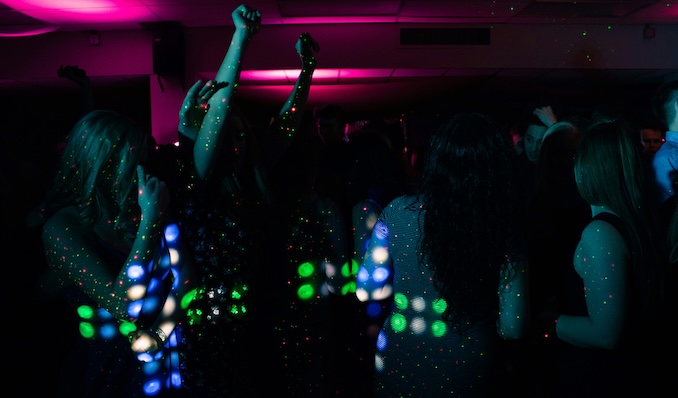Nightclubs have always been more than just places to drink or dance—they’re cultural mirrors, reflecting the music, fashion, and social energy of each era. Whether you are at the best nightclub in Calgary or in New York City, the soundtrack of the club has changed dramatically over the decades, shaped by technology, political movements, and the rise and fall of musical genres. Let’s take a walk through time and explore what dominated club sound systems from the 1950s to the present day.

1950s: Jazz, Swing, and Early Rock ’n’ Roll
Vibe: Sophisticated, live-band heavy, cocktail culture
Before the age of DJs and turntables, nightlife revolved around live music. Supper clubs and ballrooms featured big bands, swing, and jazz ensembles, with crooners like Frank Sinatra and Ella Fitzgerald filling the air. In working-class dance halls, early rock ’n’ roll and rhythm & blues started creeping in—setting the stage for the youth-oriented culture to come.
Typical Artists: Louis Prima, Ray Charles, Elvis Presley, Fats Domino
Venues: Ballrooms, supper clubs, lounges
1960s: Soul, Motown, and the Birth of Psychedelia
Vibe: Electric, danceable, socially charged
In the ‘60s, nightclubs became more integrated and expressive. Soul and Motown dominated Black and mainstream clubs alike, with grooves that got people dancing and lyrics that reflected social change. Toward the end of the decade, psychedelic rock and funk crept into late-night sets, driven by the counterculture.
Typical Artists: The Supremes, James Brown, The Beatles (later years), Otis Redding
Venues: Soul clubs, mod hangouts, psychedelic discos
1970s: Disco Fever and Funk Power
Vibe: Glamorous, inclusive, euphoric
The ’70s were the disco decade. As DJs rose to prominence and vinyl records replaced live bands in many clubs, disco turned nightlife into a collective, hedonistic experience. The music was lush, rhythmic, and emotionally charged—perfect for the dancefloor. Meanwhile, funk kept things gritty and groove-heavy, often overlapping with disco in style and crowd.
Typical Artists: Donna Summer, Chic, Bee Gees, Parliament-Funkadelic
Venues: Studio 54 (NYC), The Loft, Paradise Garage
1980s: Synthpop, Freestyle, and the Birth of House
Vibe: Flashy, experimental, global
The ‘80s saw the explosion of electronic instruments into pop and club music. Synthpop and new wave became club staples, while freestyle (Latin-infused dance-pop) emerged in NYC and Miami. Most importantly, this decade gave birth to house music in Chicago and techno in Detroit—genres that would soon reshape global club culture.
Typical Artists: Depeche Mode, Madonna, Shannon, Frankie Knuckles
Venues: The Hacienda (UK), The Warehouse (Chicago), Danceteria
1990s: Rave Culture, Hip-Hop, and Eurodance
Vibe: Wild, tribal, diverse
The ‘90s were a golden era for club diversity. In Europe, rave culture exploded with trance, hardcore, and Eurodance, while in the U.S., hip-hop and R&B took over urban clubs. House and techno grew more refined and global, while garage and drum & bass emerged in the UK. This was the era of glowsticks, oversized pants, and warehouse parties.
Typical Artists: The Prodigy, 2Pac, Snap!, Daft Punk, Armand Van Helden
Venues: Ministry of Sound (London), Limelight (NYC), Club USA
2000s: Commercial Dance, Crunk, and Electroclash
Vibe: Flashy, genre-blending, heavily produced
The 2000s club scene was defined by two major forces: hip-hop dominance and the rise of commercial electronic dance music. Artists like Usher and Lil Jon ruled the clubs with high-energy crunk and R&B hits, while DJs began mixing electro, pop, and house into massive dancefloor anthems. Subcultures like electroclash brought irony and edge, while mainstream clubs leaned into bottle service and radio-ready hits.
Typical Artists: Usher, David Guetta, Missy Elliott, Benny Benassi
Venues: Mega-clubs in Miami, Vegas, Dubai
2010s: EDM Takeover and the Global Club Scene
Vibe: Maximalist, festival-driven, global fusion
By the 2010s, EDM (Electronic Dance Music) became a global phenomenon, driven by superstar DJs and massive festivals. Big room house, dubstep, and trap EDM ruled main stages and mainstream clubs. Meanwhile, Afrobeats, Latin trap, and K-pop began to sneak into sets, especially in multicultural cities. Hip-hop remained dominant in many clubs, often woven into genre-mixed nights.
Typical Artists: Calvin Harris, Diplo, Rihanna, Drake, Major Lazer
Venues: Hakkasan (Vegas), Berghain (Berlin), Output (Brooklyn)
2020s: Genre Fluidity and Underground Revival
Vibe: Experimental, inclusive, nostalgic, post-pandemic rebirth
The early 2020s saw a shift toward genre fluidity and the revival of more intimate, DIY club scenes. Post-pandemic nightlife is defined by techno’s resurgence, the global domination of Amapiano, Afrobeats, and reggaeton, and a strong nostalgia for ’90s/2000s pop and Y2K club hits. TikTok trends often dictate what gets played, and diversity is now central to club programming.
Typical Artists: Peggy Gou, Bad Bunny, Burna Boy, Fred again.., Charli XCX
Venues: Pop-up parties, hybrid art spaces, queer-led raves, immersive warehouse scenes
A Never-Ending Remix
The evolution of club music reflects our changing cultures, technologies, and values. From ballroom jazz to Berlin techno, from Motown to Amapiano, clubs have always adapted and redefined what it means to dance together. As genres continue to blend and borders dissolve, the soundtrack of the night becomes more inclusive, dynamic, and unpredictable than ever.
Whatever the decade, one thing remains constant: people crave connection, rhythm, and release. And the club? That’s where it all comes alive.

